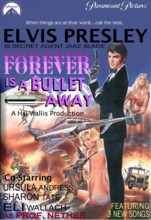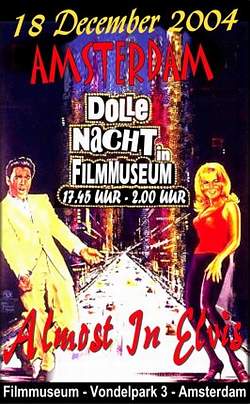

Visit EIN's Celluloid Elvis pages
The course overview, enrolment details and hand outs are outlined below.
"New Perspectives on Elvis Film" Welcome to The Elvis Film Course! Key Documents:
Over the next eight to twelve weeks you are going to experience, discover and rediscover Elvis's body of film work in a new way. Also, after studying various film techniques and concepts you will be equipped to evaluate any film you watch on several levels, from pure enjoyment to a reasonably sophisticated understanding of how and why the filmmaker has structured his or her film in a particular way. You will also know what 'tricks of the trade' the filmmaker has used and how non-film media texts reinforce deliberately devised meanings within a film. The idea is to have a lot of fun looking at what was, and still is, for many of us, an important part of our formative Elvis years. At the same time we will learn a lot more about how Elvis films were structured in ordered to heighten their appeal to his fans. A result of learning about basic film concepts is that you are unlikely to view any film in the same way again. Course Facilitator's Background:
Enrolment details (Online) Course fee: US$64.00 (compared to "in-class" fee of US$85.00) Enrolments: Limited to ten participants and enrolments close on 28 June 2006 Materials: The course fee includes:
All you will need is some spare time, a few Elvis videos/DVDs to watch, and access to one or more text books on film studies (available from your local bookstore or library). Course design: While the course includes basic technical film elements, these are presented in an easy to understand way. The course is also structured to give you a lot of fun as you learn more about Elvis films and explore the art of filmmaking. Payment options:
How to enrol: All you have to do is register with EIN by email and pay before 28 June 2006. Some participant feedback
A Brief History of Academic Studies on Elvis There have been numerous academic courses internationally including the 'Annual Conference on Elvis Presley' in Memphis. In Australia, the earliest known academic study was the ANU Film Group's series of on Elvis Films in the early 1970s. A precursor of The Elvis Film: 'B' Grade Celluloid or Star Vehicle? was run in the early 1990s at UTS in Sydney. More recently, The Elvis Film has been offered by The Canberra College (becoming the first distance learning subject in the College's history!). "New Perspectives on Elvis Film" appears to be the only "distance education" film course about Elvis currently offered. The Institute of Technology (Melbourne, Australia) has also offered an Elvis course for several years, while Griffith University, Australia introduced a three-year Bachelor of Popular Music course in 1999 - Elvis is an integral part of the course. Also in Canberra, Australia, Susan MacDougall has been presenting the course 'Elvis Presley as a Twentieth Century Phenomenon' at the University of the 3rd Age for several years. In the USA, Dr. Donald Johns faciltates a course at UC Davis, Elvis Presley: Roots, Impacts, Legacies. This course examines Elvis as a watershed in American Cultural History. Elsewhere, music professor and composer, Stephan Prock, runs the course All Shook Up: Elvis in American Culture at the University of Virginia. Also, in the US, Douglas Brode, author of 2006's highly anticipated book, Elvis Cinema & Popular Culture, has been running his own university based film course for a number of years. More about "New Perspectives on Elvis Film" (formerly offered as: "The Elvis Film: Star Vehicle or 'B' Grade Celluloid?") The course has been designed to be completed over an eight to twelve weeks period. For each module in the course there are a series of background information sheets and focus questions. In addition, participants will need to study various Elvis movies, in part or whole, to identify where and how key film concepts are used and how Elvis's film career has a number of quite distinct phases. All exercises and focus questions are shown in shade boxes. Many important points are shown in bold text. You will note that most hand-outs include learning outcomes for the particular module or subject covered. The course also includes some 'fun' pieces of Elvis Film Trivia, Elvis Film Questions and Elvis Games along the way. To optimise your learning experience it is important that you challenge the facilitator's views throughout the course. In some ways what we are about to study is a very subjective area. Let's get underway. We have included examples of several "course exercses" (see grey boxes) in the following overview to give you an idea of some of the concepts and ideas covered in the course.
The Elvis Film Course begins…. : during Module 1, participants will be famialiarising themselves with:
Learning Tip: Your learning in this segment is the foundation for the rest of the course. Work through each handout in chronological order. Throughout the course, spend some time really understanding the ideas in each handout. It will enhance your understanding if you watch a film and identify specific examples of each of the concepts, themes and devices. Initially, the idea is to study Elvis movies, although once you become familiar with many of the concepts you will find yourself automatically looking for, or finding examples of them, during your daily television viewing.
Handout #2 - Key Elements in Filmmaking: Please familarise yourself with the definitions and devices covered in this handout. They will help you understand various elements of film making throughout the course. " Exercise: For the next few weeks it is important that you look for these elements, how they are used and the emotional or psychological impact they have, when you are viewing films and television programs Handout #3 - Elvis's Film Career: A Brief Synopsis: This handout is self-explanatory and provides a brief overview of the four major phases to Elvis' film career that are the subject of this course. Handout #4 - Schematic Approaches to the Elvis Film: This handout provides an outline of four different approaches to examining or analysing Elvis' body of film work. Handout 4A - The Elvis Molecule: A different and very clever way of examining Elvis films.
Handout #5 - General Hypothesis: In this handout a general hypothesis is posed regarding Elvis' film work - a hypothesis that you will test throughout the course. Handout #6 - Star Vehicle & Star Image: This paper outlines the primary elements of what constitutes the concept of 'star vehicle' and the consistent elements present to support 'star image'. Includes several focus questions.
During Module 2, participants will be examining in some detail the range of texts, codes and film concepts used in the first three phases of Elvis' body of film work. Participants will study how and why the various concepts etc have been used differently in phases 1, 2 and 3 of Elvis' film career. The important integration of sound and vision in a film will also be explored as will examples of media texts on Elvis from the 1950s to 1970s. To begin with, review Handouts 6, 7, and 8 - 11. Handout #12 - Focus Questions Handout #13 - Sound and Vision: Not the David Bowie song, but a look at the added impact on the audience of carefully integrated sound and vision. Handout #14 - Post Army Codes: Lists a series of codes evident in Elvis's post Army films (up to 1967).
Handout #15 - The Late 60s Codes: Lists a series of codes evident in Elvis's last few narrative films. Exercise: examine this list and identify examples of the codes in several of his films made between 1967 and 1969.
By the end of Module 2 you should be comfortable with the range of film concepts studied and understand how they were used in the initial three phases of Elvis' films. You will also be able to articulate key differences in Elvis films between each of the three phases.
The final module will bring all of your learning together by you watching and analysing:
Participants will also look at the films Elvis never made or finished including 'The Pied Piper of Cleveland', 'Thunder Alley', 'A Star Is Born', 'The New Gladiators' and 'Forever Is A Bullet Away'. Handout #16 - Chart of Film & Non-Film Texts Exercise: watch an entire film from each of the first three phases of Elvis's film career and then complete the matrix. Preparatory work for the exercises in Handouts #18 & #19. Handout 16A - Chart of Film & Non-Film Texts: Provides an example of one approach to completing the matrix in Handout #16. Handout #17 - Some Scenes for Study: Presents answers/learning outcomes for some of the specific scenes studied throughout the course. Handout #18 - The Three Distinct Phases of Elvis' Diverse Film Career: Identifying the Differences Two exercises where you will identify the different set of codes at work during each of the first three phases of Elvis' film career. Exercise: Using your local library, the Internet, or your own personal Elvis collection, locate a media text from the 1950s and one from the mid-1970s. Answer these two questions: What messages (texts) do they carry and how do they differ from the texts in the Movie News article examined as Media Text 1? Handout #19 - Focus Questions for Segment 3 Handout #20 - Elvis Films - the Political Famework Handout #21 - The Films Elvis Never Made: a fun research exercise. Handout #22 - Selected Bibliography Handout #23 - Playing the Elvis Game: a fun activity based around the co-stars in Elvis's body of films. Course Evaluation Sheet PLUS a stimulating article or two Do you have a question? If you want to know more about the course Nigel Patterson either:
© Nigel Patterson, 1997/2001/2002/2003/2004/2005
|
|||||||||||||||












